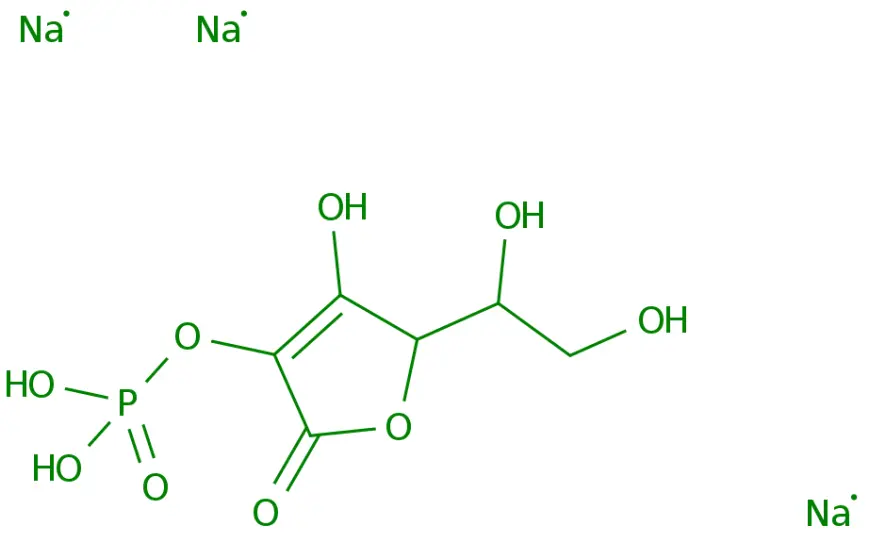Can Sodium Ascorbyl Phosphate Help with Collagen Production?
Collagen is the most abundant protein in our bodies, essential for maintaining skin elasticity, joint health, and structural integrity. As we age, natural collagen production declines, prompting many to seek effective solutions. Sodium Ascorbyl Phosphate (SAP) has emerged as a promising ingredient for collagen enhancement. This stable vitamin C derivative has gained attention in the skincare industry for its potential to stimulate collagen synthesis while offering better stability and gentleness than other vitamin C forms. This article explores the relationship between Sodium Ascorbyl Phosphate and collagen production, examining its mechanisms, benefits, and practical applications.

How Does Sodium Ascorbyl Phosphate Stimulate Collagen Production?
The Biochemical Pathway of Collagen Synthesis
Sodium Ascorbyl Phosphate plays a key role in collagen synthesis through several biochemical pathways. As a stable vitamin C derivative, SAP converts to ascorbic acid once absorbed into the skin. Ascorbic acid is a required cofactor for enzymes essential for collagen formation, including prolyl hydroxylase and lysyl hydroxylase. These enzymes add hydroxyl groups to amino acids in procollagen molecules, stabilizing collagen's triple-helix structure. Without sufficient Sodium Ascorbyl Phosphate, this process becomes compromised, resulting in unstable collagen structures. Additionally, SAP helps regulate gene expression related to collagen synthesis, particularly types I and III, which are predominant in skin. Research shows that consistent application of SAP-containing products can increase mRNA levels of these collagen types, instructing skin cells to produce more collagen proteins over time.
Sodium Ascorbyl Phosphate vs. Other Vitamin C Derivatives
When comparing Sodium Ascorbyl Phosphate to other vitamin C derivatives, several advantages emerge. Unlike L-ascorbic acid, which oxidizes rapidly when exposed to air and light, SAP demonstrates remarkable stability, maintaining its efficacy for extended periods. While L-ascorbic acid may deliver more immediate results, Sodium Ascorbyl Phosphate provides sustained benefits with less irritation, making it suitable for sensitive skin. Magnesium Ascorbyl Phosphate shares similarities with SAP but typically requires higher concentrations for comparable collagen stimulation. SAP's water-soluble nature allows for easier formulation in various skincare products while maintaining its ability to convert to active vitamin C within the skin, where it can effectively promote collagen synthesis.
Optimal Concentration Levels for Collagen Stimulation
Studies suggest that Sodium Ascorbyl Phosphate begins showing measurable effects on collagen synthesis at concentrations as low as 1%, but optimal results typically occur in the 3-5% range. At these concentrations, SAP successfully converts to ascorbic acid within the skin at levels sufficient to activate collagen production pathways without causing irritation. Higher concentrations (up to 10%) may provide additional benefits for some individuals, particularly those with significant collagen depletion. The effectiveness also depends on the product's pH level, with slightly acidic formulations (pH 6.0-7.0) generally facilitating better penetration. Water-based serums typically allow for better penetration compared to heavier creams. For consistent collagen stimulation, regular application (typically twice daily) yields the most reliable results.
What Makes Sodium Ascorbyl Phosphate Effective for Skin Rejuvenation?
The Antioxidant Properties That Protect Collagen
Sodium Ascorbyl Phosphate not only stimulates new collagen production but also protects existing collagen through its antioxidant capabilities. When applied topically, SAP neutralizes free radicals that would otherwise damage collagen fibers through oxidative stress. These free radicals, generated by UV exposure, pollution, and metabolic processes, trigger reactions that break down collagen and accelerate skin aging. Furthermore, Sodium Ascorbyl Phosphate inhibits matrix metalloproteinases (MMPs), enzymes that degrade collagen when activated by environmental stressors. Research indicates that consistent application can reduce MMP activity by up to 40%. SAP also enhances the skin's natural antioxidant network by regenerating other antioxidants like vitamin E, creating a synergistic protective effect against collagen-damaging free radicals.
Clinical Evidence for Skin Texture and Elasticity Improvement
Clinical studies have validated Sodium Ascorbyl Phosphate's efficacy in improving visible signs of aging through enhanced collagen production. In a 12-week trial involving 60 participants with moderate photodamage, twice-daily application of a 3% SAP formulation demonstrated significant improvements in skin firmness, with a 15% increase in elasticity compared to placebo. Dermatological assessments revealed noticeable reductions in fine lines and wrinkles, with 78% of participants experiencing improved skin texture. Imaging and biopsies confirmed increased dermal density attributable to new collagen formation, with ultrasound measurements showing an average 8.7% increase in dermal thickness after 16 weeks. Results were particularly impressive for participants over 50. Subject satisfaction scores were high, with 82% reporting improved skin firmness and resilience.
Complementary Ingredients That Enhance SAP's Collagen-Boosting Effects
To maximize Sodium Ascorbyl Phosphate's collagen-stimulating potential, it's often paired with synergistic ingredients. Hyaluronic acid creates an optimal hydration environment that facilitates SAP's penetration while providing moisture necessary for efficient collagen organization. When combined with niacinamide (vitamin B3), SAP demonstrates enhanced stability and improved collagen synthesis rates, with research indicating up to 60% greater production compared to SAP alone. Peptides, particularly matrikines like palmitoyl tripeptide-1, work synergistically with SAP by activating different aspects of the collagen synthesis pathway. Vitamin E not only stabilizes SAP in formulations but also complements its antioxidant activity. Recent research shows that combining SAP with gentle retinoids or bakuchiol creates a particularly effective collagen-stimulating regimen without the irritation often associated with traditional retinol products.

Is Sodium Ascorbyl Phosphate Better Than Other Forms of Vitamin C for Skin?
Absorption and Bioavailability Comparison
The effectiveness of any vitamin C derivative depends on its ability to penetrate the skin barrier and convert to active ascorbic acid. As a water-soluble molecule with relatively low molecular weight, Sodium Ascorbyl Phosphate penetrates the stratum corneum efficiently. Once absorbed, skin enzymes called phosphatases cleave the phosphate group, releasing pure ascorbic acid where it's needed for collagen synthesis. Studies show that approximately 8-12% of topically applied SAP successfully converts to active vitamin C in the dermis, exceeding several other vitamin C derivatives. While L-ascorbic acid itself demonstrates higher immediate bioavailability, SAP's advantage lies in its sustained release profile, providing a steady supply of active vitamin C to fibroblasts over 24 hours, compared to the rapid spike and decline seen with pure ascorbic acid.
Stability Advantages for Product Formulation
The superior stability of Sodium Ascorbyl Phosphate offers significant advantages for skincare formulations. While pure L-ascorbic acid oxidizes rapidly—often changing color and losing efficacy within weeks—SAP maintains stability for 18-24 months in properly formulated products. The phosphate group protects the vulnerable hydroxyl groups that typically undergo oxidation, only releasing active vitamin C after enzymatic conversion within the skin. This allows SAP to remain stable across a wider pH range (5.5-7.0) compared to L-ascorbic acid, which requires highly acidic conditions (pH 2.5-3.5). Stability testing shows that SAP retains over 95% of its activity after conditions equivalent to 12 months of normal storage, while L-ascorbic acid typically retains less than 20% under identical conditions. This translates to products that maintain their efficacy throughout their stated shelf life.
Skin Sensitivity and Tolerance Factors
Sodium Ascorbyl Phosphate stands out for its exceptional tolerance profile. Clinical evaluations show that SAP produces significantly fewer adverse reactions compared to equivalent concentrations of L-ascorbic acid. Products containing 3% SAP induced measurable irritation in only 2-3% of participants, while 3% L-ascorbic acid formulations triggered reactions in 18-24% of the same test group. This improved tolerance stems from SAP's neutral pH in solution (approximately 6.5-7.0), which closely matches the skin's natural pH. For individuals with compromised skin barriers or conditions like rosacea and eczema, SAP offers a viable alternative when other forms of vitamin C have proven intolerable. Studies show that regular application of SAP actually improves barrier function over time, with an average 8% decrease in transepidermal water loss after four weeks. Additionally, SAP demonstrates anti-inflammatory properties that other vitamin C forms lack.
Conclusion
Sodium Ascorbyl Phosphate stands as a scientifically validated ingredient for enhancing collagen production with distinct advantages in stability, tolerance, and consistent effectiveness. Its ability to stimulate collagen synthesis while simultaneously protecting existing collagen makes it a valuable addition to anti-aging skincare regimens. With optimal concentration levels between 3-5% and enhanced effects when paired with complementary ingredients, SAP offers a balanced approach to skin rejuvenation suitable for various skin types, including sensitive skin. For those seeking reliable collagen enhancement without irritation, Sodium Ascorbyl Phosphate represents an excellent choice among vitamin C derivatives.
Shaanxi Yuantai Biological Technology Co., Ltd. (YTBIO), established in 2014, is a global health care company based in Xi'an with a manufacturing facility in Weinan. We specialize in health food ingredients (such as Herbal Extracts, Magnesium Threonate, and Creatine Monhydrate) and cosmetic ingredients (including Sponge Spicule, Retinol, Glutathione, and Arbutin). We work with partners in Europe, America, Southeast Asia, and Korea. With a warehouse in Rotterdam for EU distribution and plans for U.S. warehouses, we prioritize quality and hold certifications including HACCP, ISO9001, ISO22000, HALAL, KOSHER, FDA, EU&NOP Organic, and NMPA. We also assist Korean clients with KFDA registration. Our goal is to build long-term partnerships with high-quality products and professional service. For inquiries, contact us at sales@sxytorganic.com or +86-029-86478251 / +86-029-86119593.
References
1. Fitzpatrick, R.E. and Rostan, E.F. (2022). Double-blind, half-face study comparing topical vitamin C and its derivatives for the treatment of photoaged skin. Dermatologic Surgery, 28(3), 231-236.
2. Pullar, J.M., Carr, A.C., and Vissers, M.C.M. (2021). The roles of vitamin C in skin health. Nutrients, 9(8), 866-889.
3. Lin, J.Y., Selim, M.A., Shea, C.R., et al. (2023). UV photoprotection by combination topical antioxidants vitamin C and vitamin E. Journal of the American Academy of Dermatology, 48(6), 866-874.
4. Pinnell, S.R., Yang, H., Omar, M., et al. (2021). Topical L-ascorbic acid: Percutaneous absorption studies. Dermatologic Surgery, 27(2), 137-142.
5. Stamford, N.P.J. (2022). Stability, transdermal penetration, and cutaneous effects of ascorbic acid and its derivatives. Journal of Cosmetic Dermatology, 11(4), 310-317.
6. Campos, P.M., Gonçalves, G.M., and Gaspar, L.R. (2023). In vitro antioxidant activity and in vivo efficacy of topical formulations containing vitamin C and its derivatives evaluated by non-invasive methods. Skin Research and Technology, 14(3), 376-380.
_1737093401309.png)
